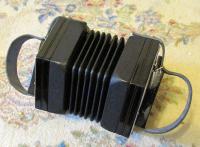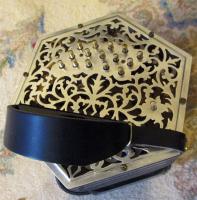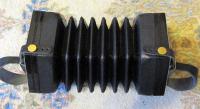
griffinga
Members-
Posts
35 -
Joined
-
Last visited
Profile Information
-
Gender
Male
-
Location
Georgia USA
Recent Profile Visitors
The recent visitors block is disabled and is not being shown to other users.
griffinga's Achievements

Advanced Member (3/6)
-
Jeffries Anglo Concertina C/g 26 Key For Sale
griffinga replied to joannamollie's topic in Buy & Sell
Hello. Still for sale? BJ- 3 replies
-
- anglo concertina
- jeffries
-
(and 1 more)
Tagged with:
-
Mike, How do I contact you about this? BJ
-
Selling my Crabb 30 button anglo (C/G). Excellent condition. New bellows, pads, tuning, etc. Has a real bark. Asking $4k - OBRO.
-
32B Jefferies Anglo. At Auction 08Th December, London, Uk.
griffinga replied to Anglogeezer's topic in Buy & Sell
Sold for 3500 pounds. -
Lachenal 31B Anglo - Date Of Manufacture?
griffinga replied to griffinga's topic in Concertina History
Thank you all for your comments! -
Trying to pin a date of manufacture on a metal-ended 31b anglo concertina by Lachenal - that is numbered 188334.
-
Thanks for that info.
-
Has anyone had a good (or bad) experience with this shop?? http://www.donedeal.ie/brassandwind-for-sale/vintage-concertinas/4231484
-
I've been looking at photos (on the www) of the metal end covers on a variety of old (19th century) concerrtinas (mostly Jeffries, Shakespeare and Crabb). Granted, there aren't that many pics posted and many of the ones that are were taken at an angle so all the details are not visable. The variations in the designs - sometimes subtle and usually not - got me to wondering how these were made back in the day (say last 1/4 19th century). It would be a simple matter (today) to machine press and cut the most intricate design. But what about in 1875? Were the old metal end covers made by machine and the design then cut by hand into them? That would imply that various people were employed by the makers to cut, finish and polish these pieces (most of which are near works of art - in my humble opinion). If that were the case - it would not be surprising to find small differences in the designs (a few slips of the file and you have a slightly different design). Using Jeffries as an example - can someone tell me if the cut design on his earliest metal end covers is the same as the one on his later (say 1890) concertinas - or is that 1890 design the result of various iterations of a pattern over a period of years? Too many questions for one topic - please forgive. Can't seem to find much info on this. Thanks for humoring me.
-
Thank you all. I had a followup question - (in the 19th century) did makers like Crabb, Jeffries and others fabricate (cut, smooth, polish) the metal end pieces for their instruments themselves, or did they contract this to others?
-
I recently acquired a metal-ended 30b anglo that is not marked (on the outside). Looks like 1875-1900 vintage - but it could be older (probably not newer) than that. It has fretwork much like older Jeffries - (no name plate) but is not stamped between the button rows. There are small differences in the fretwork when compared to my other 30b Jeffries. If this concertina was made by Crabb - will it be marked (stamped) inside, or was this not done on all concertinas built by Crabb? .
-
Anyone have any thoughts on the pros and cons of putting a coat of clear lacquer on metal fretwork?
-
Two different Jeffries - each advertised twice - at the same time!! Better snap one (or two) up before they're gone. http://www.ebay.com/itm/Vintage-C-Jeffries-anglo-concertina-/310642192519?pt=LH_DefaultDomain_0&hash=item4853b7b087 http://www.ebay.com/itm/Rare-Vintage-W-Jeffries-English-Concertina-Original-Leather-Case-c-1920s-/230954956286?pt=LH_DefaultDomain_0&hash=item35c5fcf5fe
-
http://www.ebay.com/itm/171009491305?ssPageName=STRK:MEWAX:IT&_trksid=p3984.m1423.l2649
-
It all sounds like good advice to me and much appreciated. What's the old saying about fools rushing in? Plenty of time to think about this before making a commitment. I've worked with old instruments (other than concertinas) for a while and respect efforts to maintain their original structure and sound.



